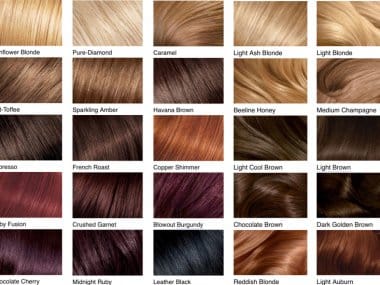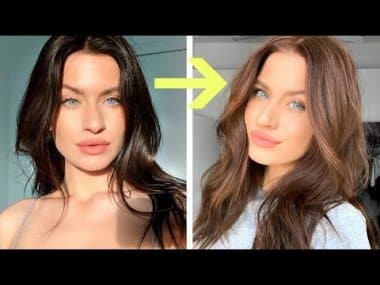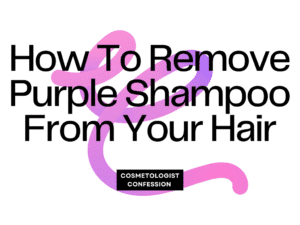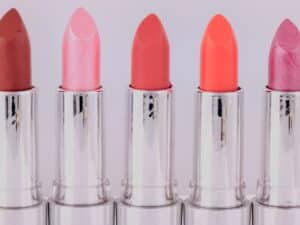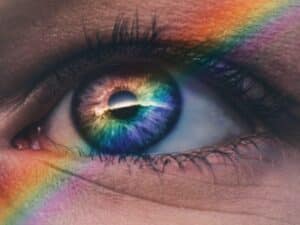Thanks to science and genetics, people can change their hair in a few hours and can choose even to change its color permanently, semi-permanently, or temporarily permanently.
There is more to hair color than just brushes and foils; quite a bit of science and creativity goes into hair color.
Below are some fun hair facts that will have you googling to double-check that they are for real!
Don’t worry; you don’t need to google if AI wrote this. This information comes from me, who has been a cosmetologist for 20 years, and gives you the best information from my authentic voice.
Contents
1. Hair color is determined by the amount and type of melanin in the hair shaft.
The quantity and specific type of melanin present within the hair shaft primarily determine hair color.
What does this mean? Well, to understand that, you need to know what melanin is. Let me quickly break it down for you.
Melanin is a pigment that provides color not only to our hair but also to our skin and eyes. Two key types of melanin play a pivotal role in defining our hair color:
- Eumelanin: This type of melanin produces shades of brown and black. The more eumelanin present in the hair, the darker its color will be. Black hair typically contains a higher concentration of eumelanin, while brown hair has a more balanced mix of eumelanin and pheomelanin.
- Pheomelanin: Pheomelanin contributes to red and blonde hair colors. A reddish or yellowish hue characterizes it. Hair with more pheomelanin and less eumelanin will appear lighter, creating shades of red or blonde.
The specific combination and proportion of these two melanin types in the hair shaft result in the wide array of hair colors we observe, ranging from deep, jet black to fiery reds and sunny blondes. Additionally, genetics play a significant role in determining how these melanin types are distributed, which is why hair color often runs in families. For this reason, you find children looking like mini versions of their parents since their hair and eye colors could match exactly.
Some combinations skip generations, which can lead to a hair color surprise as your child ages. This is common with redheads and may be why a family has a single child with red hair that matches a great-great-great-grandparent, and their cousins might have dark or light hair.
As we age, hormonal changes, genetics, and environmental factors can influence melanin production within our hair follicles, leading to changes in hair color over time. Understanding the role of melanin in hair color helps to unravel the mysteries of why our hair looks the way it does and why it can change as we journey through life.
2. To properly go from blonde to dark hair, you need to use a filler color of red.
Red hair dye is often recommended as an intermediate step to transition from blonde to brunette. This is also known as a filler color.
First, the red dye is applied to the blonde hair. This process will look similar to an all-over color job, and some stylists may charge you for the color used or a full-color service.
This step helps to introduce warm undertones, counteracting any potential greenish or ashy tones that might arise when light hair is darkened. It also assists in providing a smoother transition, avoiding a stark contrast between the two hair colors.
Even if you want a cool color, it is best to use a filler color to help rebond the hair cuticle and have the ash undertone turn out more blue than puke green.
This is especially important when people want to go from blonde to a subtle light brown hair color change.
*I always just charged for the product used and didn’t charge for a double color charge since I’m from the Midwest, and that’s on trend for me. Some stylists might call me stupid but to each their own. I knew my clients at the salon were already splurging to get their hair done, so I didn’t want to take advantage of them.

Once the red dye has been applied and processed, it’s followed by applying the desired brunette hair color. The red undertones serve as a bridge, allowing the brunette shade to appear richer and more natural, resulting in a balanced and multi-dimensional brunette hair color that complements the individual’s skin tone.
3. Hair contains no DNA.
Being a cosmetologist, this fun fact was not taught to me in school, and I found it to be one of the most interesting hair facts.
While hair can be used for forensic analysis, it doesn’t contain DNA. Instead, DNA can be found in the hair follicles and roots.
Hair itself does not contain DNA, but it can be a source of DNA if it is still attached to the hair follicle or root. Let me explain the distinction:
- Hair Shaft: The visible part of a hair strand, which extends beyond the skin’s surface, does not contain living cells. It consists mainly of a protein called keratin. Since it lacks living cells, the hair shaft itself does not have DNA.
- Hair Follicle or Root: The base of the hair strand is called the hair follicle or root. This is where living cells are located, including cells with DNA. If the hair is pulled from the root and the root is preserved, it can potentially be a source of DNA. This is why hair with the root intact is preferred in forensics or DNA testing because it can yield DNA for analysis.
4. On average, human hair grows at a rate of about half an inch (1.25 cm) per month.
This one was always pretty obvious to me, even before I went to cosmetology school.
The average rate of human hair growth is about half an inch (1.25 cm) per month. However, it’s important to note that individual growth rates can vary significantly. Some people may experience faster or slower growth; factors like genetics, age, diet, and overall health can influence hair growth.
Women taking prenatal vitamins will typically have faster hair growth. That is a trick I use to tell my clients even if they weren’t trying to get pregnant. If you want your hair or nails to grow fast, take prenatal or biton supplements. The supplements help the hair grow and make them stronger, which helps prevent breakage.
Hair growth is not continuous but occurs in cycles. There are three main phases in the hair growth cycle:
- Anagen: This is the active growth phase, where hair is actively growing. It can last for several years.
- Catagen: This is a transitional phase where hair growth slows down and the hair follicle shrinks.
- Telogen: This is the resting phase when the hair no longer grows and eventually falls out. New hair begins to grow, and the cycle repeats.
The rate of growth can also vary based on your hair type. People with different hair textures, such as straight, wavy, curly, or coily, may perceive their hair growth differently because of how these textures coil or curl.
5. Hair turns gray or white due to the natural aging process.
Hair turns gray as a natural part of the aging process, and this graying is primarily attributed to changes in the pigment-producing cells in the hair follicles.
As we age, the activity of melanocytes tends to decrease. The exact age at which this graying process begins and the rate at which it progresses can vary from person to person and is influenced by genetics.
Some evidence suggests that extreme stress may contribute to premature graying.
Smoking has been associated with an increased likelihood of premature graying.
A Point Of No Return
Once hair turns gray or white, it generally cannot naturally be reversed to its original color. Hair dyes or color treatments are typically used to restore or change the color.
Depending on how much upkeep a person wants, it might be best to do an all-over grey color to skip the long process of going gray naturally. For those who want more dimension in their hair, a heavy gray highlight mixed with darker lowlights is also a beautiful option.

6. A single strand of hair can stretch up to 30% of its original length when wet.
Once I explain, this one might have turned a light bulb on in your head.
Hair, which is primarily composed of a protein called keratin, does indeed have the ability to stretch when wet. It’s estimated that a single strand of hair can stretch up to 30% or even more of its original length when it’s fully saturated with water. This is because water can penetrate the hair shaft, causing the protein molecules in the hair to loosen and become more flexible temporarily.
However, it’s important to note that this stretching ability is temporary and reversible. When the hair dries, it returns to its original length and shape. This property of hair can be both advantageous and disadvantageous, as it can make hair more manageable when wet and more susceptible to damage if handled roughly or subjected to excessive tension while wet. To minimize the risk of hair damage, it’s recommended to be gentle when handling wet hair and to avoid activities that could cause excessive stretching, such as vigorous brushing or combing.
For these reasons, you might feel that a haircut is too long when cut wet, but it sits at the perfect length when dry. No fear; every professional cosmetologist knows this fact and considers it when cutting damp hair.
This is also why you should be extra careful when brushing your hair when wet because it is more prone to snap and break when stretched out.
7. Losing around 50 to 100 hairs from your scalp daily is normal as part of the natural hair growth cycle.
I’m unsure if this is helpful or harmful information to tell your spouse the next time they complain about finding your hair everywhere. On the one hand, they are correct, but on the other hand, it is just a part of being a human, so it’s not your fault you leave a trail of hair behind you.
This phenomenon is known as hair shedding, and it is a normal and natural process. Hair goes through different phases of growth, including the anagen (growth) phase, the catagen (transitional) phase, and the telogen (resting) phase. During the telogen phase, new hair growth pushes the old hair out, leading to some degree of shedding.
Factors like age, genetics, hormonal changes, and overall health can influence the rate of hair shedding. While shedding is a normal part of the hair growth cycle, excessive hair loss may indicate an underlying medical condition or other factors, such as poor nutrition, stress, or certain medications. If you are concerned about excessive hair loss, it’s a good idea to consult a healthcare professional or dermatologist for a thorough evaluation and to rule out any underlying issues.
You might feel like some days you shed more hair than others, and the most significant factor in that is how often you wear your hair up vs down and how frequently you brush your hair.
I know for me, I wear my hair up a ton and don’t take the time to do tons of brushing, so when I do, it really sheds. I give my Shepsky a run for her money on wash and brush days.
8. There is a hair condition called Rapunzel Syndrome
I promise you I am not making this up. I even linked it for you if you are so inclined to learn more about it.
Rapunzel syndrome is a rare medical condition in which a person, typically a young female with trichotillomania (a compulsive hair-pulling disorder), ingests their hair. Over time, the ingested hair forms a large hairball in the stomach, which can extend into the small intestine, resembling the long hair of the fairy tale character Rapunzel. This condition can lead to serious digestive issues, blockages, and other health complications, often requiring surgical intervention to remove the hairball.
In most cases, surgical intervention is required to remove the hairball and repair any damage it may have caused to the digestive tract. Surgery is often necessary to prevent further complications and alleviate the patient’s symptoms. AKA, you aren’t a cat and can’t just cough up a hairball on your own.



